Effect of Step Size on the Formability of Al/Cu Bimetallic Sheets in Single Point Incremental Sheet Forming
Abstract
1. Introduction
2. Materials and Methods
2.1. Test Material
2.2. Experimental Setup
2.3. Analysis of Variance
3. Results and Discussions
3.1. Mechanical Properties of as-Received Al/Cu Bimetallic Sheet
3.2. Surface Quality
3.3. Maximum Forming Angle
3.4. Wall Thickness
3.5. Deviation of Wall Geometry
3.6. Surface Roughness
3.7. Hardness
3.8. Microstructural Observation of CuAl Interface
3.9. Mechanical Properties of Bimetallic Sheet after SPIF
4. Discussion
5. Conclusions
- -
- The difference in the Erichsen Index IE value of the bimetallic sheet tested from the aluminum side of the sheet is 6% larger than that of the sheet formed from the copper side of the sheet;
- -
- Step size is the basic parameter that determines the formability of the material; increasing it to over 1.1 mm resulted in the rupture of the drawpiece material;
- -
- Step size also strongly influences the springback phenomenon; the larger the step size, the greater the deviation of the drawpiece geometry from the desired geometry;
- -
- The greater the step size, the more the wall angle after springback deviates from the desired profile;
- -
- Forming an Al/Cu bimetallic sheet from the aluminum side of the sheet permits drawpieces with a larger wall angle to be obtained;
- -
- The layer arrangement is not a statistically significant parameter influencing the average roughness of drawpieces;
- -
- From the two-layer arrangements examined in the range of step size between 0.7 and 1.0 mm, greater thinning of the sheet occurred during SPIF from the aluminium side of the sheet, while in SPIF of the bimetallic sheet from the copper side of the sheet, the greatest thinning was observed at Δz ≤ 0.6 mm and Δz ≥ 1.1 mm;
- -
- Observation of the sheet cross-section shows that no gaps or voids are seen in the surface joining the sheets, demonstrating great adhesion between the layers.
Author Contributions
Funding
Institutional Review Board Statement
Informed Consent Statement
Data Availability Statement
Conflicts of Interest
References
- Kim, Y.H.; Park, J.J. Effect of process parameters on formability in incremental forming of sheet metal. J. Mater. Process. Technol. 2002, 130, 42–46. [Google Scholar] [CrossRef]
- Leszak, E. Apparatus and Process for Incremental Dieless Forming. US3342051A, 19 September 1967. [Google Scholar]
- Tisza, M. General Overview of Sheet Incremental Forming; Department of Mechanical Technology, University of Miskolc: Miskolc, Hungary, 2012. [Google Scholar]
- Shankar, R.; Jadhav, S.; Goebel, R.; Homberg, W.; Kleiner, M. Incremental sheet metal forming of performed sheets. In Proceedings of the 8th International Conference on Thechnology of Plasticity 2005, Verona, Italy, 9–13 October 2005. [Google Scholar]
- Jeswiet, J.; Micari, F.; Hirt, G.; Bramley, A.; Duflou, J.; Allwood, J. Asymmetric Single Point Incremental Forming of Sheet Metal. CIRP Ann.—Manuf. Technol. 2005, 54, 88–114. [Google Scholar] [CrossRef]
- Martins, P.A.F.; Kwiatkowski, L.; Franzen, V.; Tekkaya, A.E.; Kleiner, M. Single point incremental forming of polymers. CIRP Ann. 2009, 58, 229–232. [Google Scholar] [CrossRef]
- Li, Y.; Chen, X.; Liu, Z.; Sun, J.; Li, F.; Li, J.; Zhao, G. A review on the recent development of incremental sheet-forming process. Int. J. Adv. Manuf. Technol. 2017, 92, 2439–2462. [Google Scholar] [CrossRef]
- Wu, S.H.; Reis, A.; Andrade Pires, F.M.; Santos, A.D.; Barara da Rocha, A. Study of tool trajectory in incremental forming. Adv. Mater. Res. 2012, 472, 1586–1591. [Google Scholar] [CrossRef]
- Jeswiet, J. Asymmetric Incremental Sheet Forming. Adv. Mater. Res. 2005, 6–8, 35–58. [Google Scholar] [CrossRef]
- Skjoedt, M.; Bay, N.; Endelt, B.; Ingarao, G. Multi stage strategies for single point incremental forming of a cup. Int. J. Mater. Form. 2008, 1, 1199–1202. [Google Scholar] [CrossRef]
- Thibaud, S.; Ben Hmida, R.; Richard, F.; Malécot, P. A fully parametric toolbox for the simulation of single point incremental sheet forming process: Numerical feasibility and experimental validation. Simul. Model. Pract. Theory 2012, 29, 32–43. [Google Scholar] [CrossRef][Green Version]
- Li, Y.; Daniel, W.J.T.; Meehan, P.A. Deformation analysis in single-point incremental forming through finite element simulation. Int. J. Adv. Manuf. Technol. 2017, 88, 255–267. [Google Scholar] [CrossRef]
- Bologa, O. Incremental forming—An alternative to traditional manufacturing methods. Proc. Manuf. Syst. 2014, 9, 131–136. [Google Scholar]
- Lu, B.; Zhang, H.; Xu, D.K.; Chen, J. A Hybrid Flexible Sheet Forming Approach Towards Uniform Thickness Distribution. Procedia CIRP 2014, 18, 244–249. [Google Scholar] [CrossRef]
- Ambrogio, G.; Bruschi, S.; Gagliardi, F.; Ghiotti, A.; Filice1, L. Impact of high speed incremental forming on material properties of AA6082 sheets. In Key Engineering Materials; Trans Tech Publications Ltd.: Bäch, Switzerland, 2014; Volume 622–623, pp. 406–412. [Google Scholar]
- Jiang, W.; Miura, T.; Otsu, M.; Okada, M.; Matsumoto, R.; Yoshimura, H.; Muranaka, T. Development of Friction Stir Incremental Forming Process Using Penetrating Tool. Procedia Eng. 2017, 207, 789–794. [Google Scholar] [CrossRef]
- Ham, M.; Jeswiet, J. Single Point Incremental Forming and the forming criteria for AA3003. CIRP Ann. 2006, 55, 241–244. [Google Scholar] [CrossRef]
- Fontanari, V.; Benedetti, M.; Bruschi, S.; Fuganti, A. Numerical and Experimenta Lanalysis of the Single Point Sheets Incremental Forming Process; Dipartimento di Ingegneria dei Materiali e Technologie Industriali, University of Trento: Trento, Italy, 2015. [Google Scholar]
- Suresh, K.; Bagade, S.D.; Regalla, S.P. Deformation behavior of extra deep drawing steel in single-point incremental forming. Mater. Manuf. Process. 2015, 30, 1202–1209. [Google Scholar] [CrossRef]
- Fratini, L.; Ambrogio, G.; Di Lorenzo, R.; Filice, L.; Micari, F. Influence of mechanical properties of the sheetmaterial on formability in single point incremental forming. CIRP Ann. 2004, 53, 207–210. [Google Scholar] [CrossRef]
- Kumarab, A.; Gulati, V.; Kumar, P.; Singh, V.; Kumar, B.; Singh, H. Parametric effects on formability of AA2024-O aluminium alloy sheets in single point incremental forming. J. Mater. Res. Technol. 2019, 8, 1461–1469. [Google Scholar] [CrossRef]
- Zhang, Q.; Xiao, F.; Guo, H.; Li, C.; Gao, L.; Guo, X.; Han, W.; Bondarev, A.B. Warm negative incremental forming of magnesium alloy AZ31 sheet: New lubricating method. J. Mater. Process. Technol. 2010, 210, 323–329. [Google Scholar] [CrossRef]
- Gottmann, A.; Diettrich, J.; Bergweiler, G.; Bambach; Bambach, M.; Hirt, G.; Loosen, P. Laser assisted asymmetric incremental sheet forming of titanium sheet metal parts. Prod. Eng. 2011, 5, 263–271. [Google Scholar] [CrossRef]
- Zhu, H.; Hengan Ou Popov, A. Incremental sheet forming of thermoplastics: A review. Int. J. Adv. Manuf. Technol. 2020, 111, 565–587. [Google Scholar] [CrossRef]
- Arfa, H.; Ben Abdelkader, W.; Bahloul, R. Numerical study of SPIF process of Al-Cu bimetal sheet using finite element analysis: Influence of process parameters on the mechanical and geometrical responses. In Proceedings of the International Conference Design and Modeling of Mechanical Systems—CMSM 2019, Hammamet, Tunisia, 18–20 March 2019; pp. 1–10. [Google Scholar]
- Gheysarian, A.; Honarpisheh, M. Process Parameters Optimization of the Explosive-Welded Al/Cu Bimetal in the Incremental Sheet Metal Forming Process. Iran. J. Sci. Technol. Trans. Mech. Eng. 2019, 43, 945–956. [Google Scholar] [CrossRef]
- Liu, Z.; Li, G. Single point incremental forming of Cu-Al composite sheets: A comprehensive study on deformation behaviors. Arch. Civ. Mech. Eng. 2019, 19, 484–502. [Google Scholar] [CrossRef]
- Honarpisheh, M.; Mohammadi Jobedar, M.; Alinaghian, I. Multi-response optimization on single-point incremental forming of hyperbolic shape Al-1050/Cu bimetal using response surface methodology. Int. J. Adv. Manuf. Technol. 2018, 96, 3069–3080. [Google Scholar] [CrossRef]
- Sakhtemanian, M.R.; Honarpisheh, M.; Amini, S. A novel material modeling technique in the single-point incremental forming assisted by the ultrasonic vibration of low carbon steel/commercially pure titanium bimetal sheet. Int. J. Adv. Manuf. Technol. 2019, 102, 473–486. [Google Scholar] [CrossRef]
- Sakhtemanian, M.; Amini, S.; Honarpisheh, M. Simulation and Investigation of Mechanical and Geometrical Properties of St/CP-Titanium Bimetal Sheet during the Single Point Incremental Forming Process. Iran. J. Mater. Form. 2018, 5, 1–8. [Google Scholar]
- Rahmatabadi, D.; Tayyebi, M.; Najafizadeh, N.; Hahemi, R.; Rajabi, M. The influence of post-annealing and ultrasonic vibration on the formability of multilayered Al5052/MgAZ31B composite. Mater. Sci. Technol. 2021, 37, 78–85. [Google Scholar] [CrossRef]
- Yang, Y.; Gong, Y.; Li, G.; Wen, X.; Sun, J. Mechanical performance of 316 L stainless steel by hybrid directed energy deposition and thermal milling process. J. Mater. Process. Technol. 2021, 291, 117023. [Google Scholar] [CrossRef]
- Yang, M.; Li, C.; Zhang, Y.; Jia, D.; Zhang, X.; Hou, Y.; Li, R.; Wang, J. Maximum undeformed equivalent chip thickness for ductile-brittle transition of zirconia ceramics under different lubrication conditions. Int. J. Mach. Tools Manuf. 2017, 122, 55–65. [Google Scholar] [CrossRef]
- Cui, X.; Li, C.; Zhang, Y.; Said, Z.; Debnath, S.; Sharma, S.; Ali, H.M.; Yang, M.; Gao, T.; Li, R. Grindability of titanium alloy using cryogenic nanolubricant minimum quantity lubrication. J. Manuf. Process. 2022, 80, 273–286. [Google Scholar] [CrossRef]
- Wang, X.; Li, C.; Zhang, Y.; Ali, H.M.; Sharma, S.; Li, R.; Yang, M.; Said, Z.; Liu, X. Tribology of enhanced turning using biolubricants: A comparative assessment. Tribol. Int. 2022, 174, 107766. [Google Scholar] [CrossRef]
- Trzepiecinski, T.; Lemu, H.G. Recent Developments and Trends in the Friction Testing for Conventional Sheet Metal Forming and Incremental Sheet Forming. Metals 2020, 10, 47. [Google Scholar] [CrossRef]
- Azevedo, N.G.; Farias, J.S.; Bastos, R.P.; Teixeira, P.; Davim, J.P.; de Sousa, R.J.A. Lubrication aspects during Single Point Incremental Forming for steel and aluminum materials. Int. J. Precis. Eng. Manuf. 2015, 16, 589–595. [Google Scholar] [CrossRef]
- Lee, B.H.; Keum, Y.K.; Wagoner, R.H. Modeling of the Friction Caused by Lubrication and Surface Roughness in Sheet Metal Forming. J. Mater. Process. Technol. 2002, 130–131, 60–63. [Google Scholar] [CrossRef]
- Najm, S.M.; Paniti, I.; Viharos, Z.J. Lubricants and Affecting Parameters on Hardness in SPIF of AA1100 Aluminium. In Proceedings of the 17th IMEKO TC 10 and EUROLAB Virtual Conference “Global Trends in Testing, Diagnostics & Inspection for 2030”, Online, 20–22 October 2020; pp. 387–392. [Google Scholar]
- Şen, N.; Şirin, Ş.; Kiwak, T.; Civek, T.; Seçgin, Ö. A new lubrication approach in the SPIF process: Evaluation of the applicability and tribological performance of MQL. Tribol. Int. 2022, 171, 107546. [Google Scholar] [CrossRef]
- Xu, D.; Wu, W.; Malhotra, R.; Chen, J.; Lu, B.; Cao, J. Mechanism investigation for the influence of tool rotation and laser surface texturing (LST) on formability in single point incremental forming. Int. J. Mach. Tools Manuf. 2013, 73, 37–46. [Google Scholar] [CrossRef]
- Jawale, K.; Duarte, J.F.; Reis, A.; Silva, M.B. Microstructural investigation and lubrication study for single point incremental forming of copper. Int. J. Solids Struct. 2018, 151, 145–151. [Google Scholar] [CrossRef]
- Najm, S.M.; Paniti, I. Investigation and machine learning-based prediction of parametric effects of single point incremental forming on pillow effect and wall profile of AlMn1Mg1 aluminum alloy sheets. J. Intell. Manuf. 2022. [Google Scholar] [CrossRef]
- Trzepieciński, T. Polynomial Multiple Regression Analysis of the Lubrication Effectiveness of Deep Drawing Quality Steel Sheets by Eco-Friendly Vegetable Oils. Materials 2022, 15, 1151. [Google Scholar] [CrossRef]
- Maksymowych, W.; Kumke, T.; Auteri, S.; Hoepken, B.; Bauer, L.; Rudwaleit, M. Predictors of Response in Patients with Non-Radiographic Axial Spondyloarthritis Receiving Certolizumab Pegol in the C-axSpAnd Study. In Proceedings of the ACR Conference, Virtual, 16–19 May 2020. [Google Scholar]
- Wang, H.; Zhang, R.; Zhang, H.; Hu, Q.; Chen, J. Novel strategies to reduce the springback for double-sided incremental forming. Int. J. Adv. Manuf. Technol. 2018, 96, 973–979. [Google Scholar] [CrossRef]
- Ren, H.; Xie, J.; Liao, S.; Leem, D.; Ehmann, K.; Cao, J. In-situ springback compensation in incremental sheet forming. CIRP Ann. 2019, 68, 317–320. [Google Scholar] [CrossRef]
- Valinezhad, M.; Etemadi, E.; Hashemi, R.; Valinezhad, M. Experimental and FE analysis on spring-back of copper/aluminum layers sheet for a L-die bending process. Mater. Res. Express 2019, 6, 1165h4. [Google Scholar] [CrossRef]
- Babu, S.C.; Senthil Kumar, V.S. Effects of Process Variables during Incremental Forming of Deep Drawing Steel Sheets. Eur. J. Sci. Res. 2012, 80, 50–56. [Google Scholar]
- Riaz, A.A.; Hussain, G.; Ullah, N.; Wei, H.; Alkahtani, M.; Khan, M.N. An investigation on the effects of tool rotational speed and material temper on post-ISF tensile properties of Al2219 alloy. J. Mater. Res. Technol. 2021, 10, 853–867. [Google Scholar] [CrossRef]
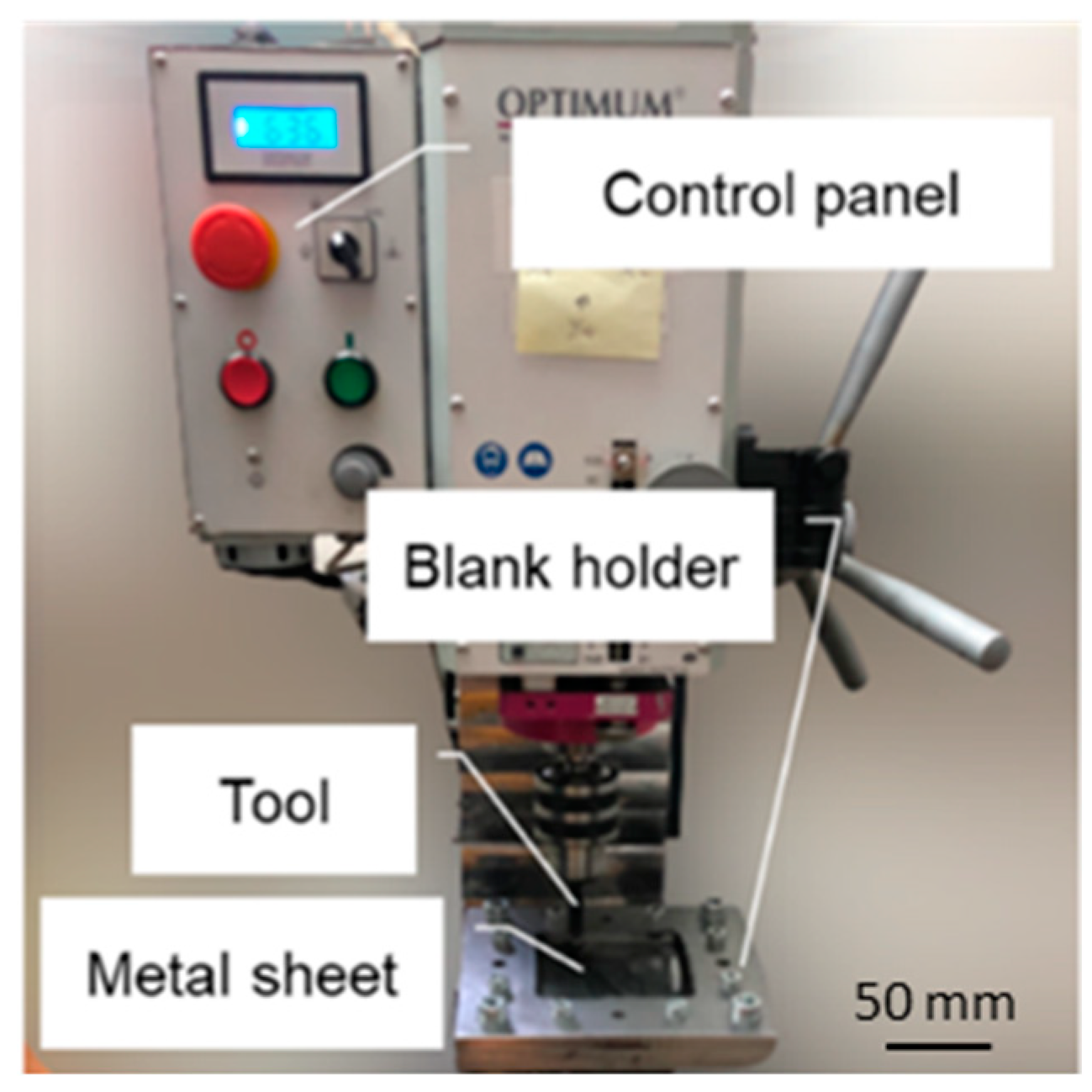
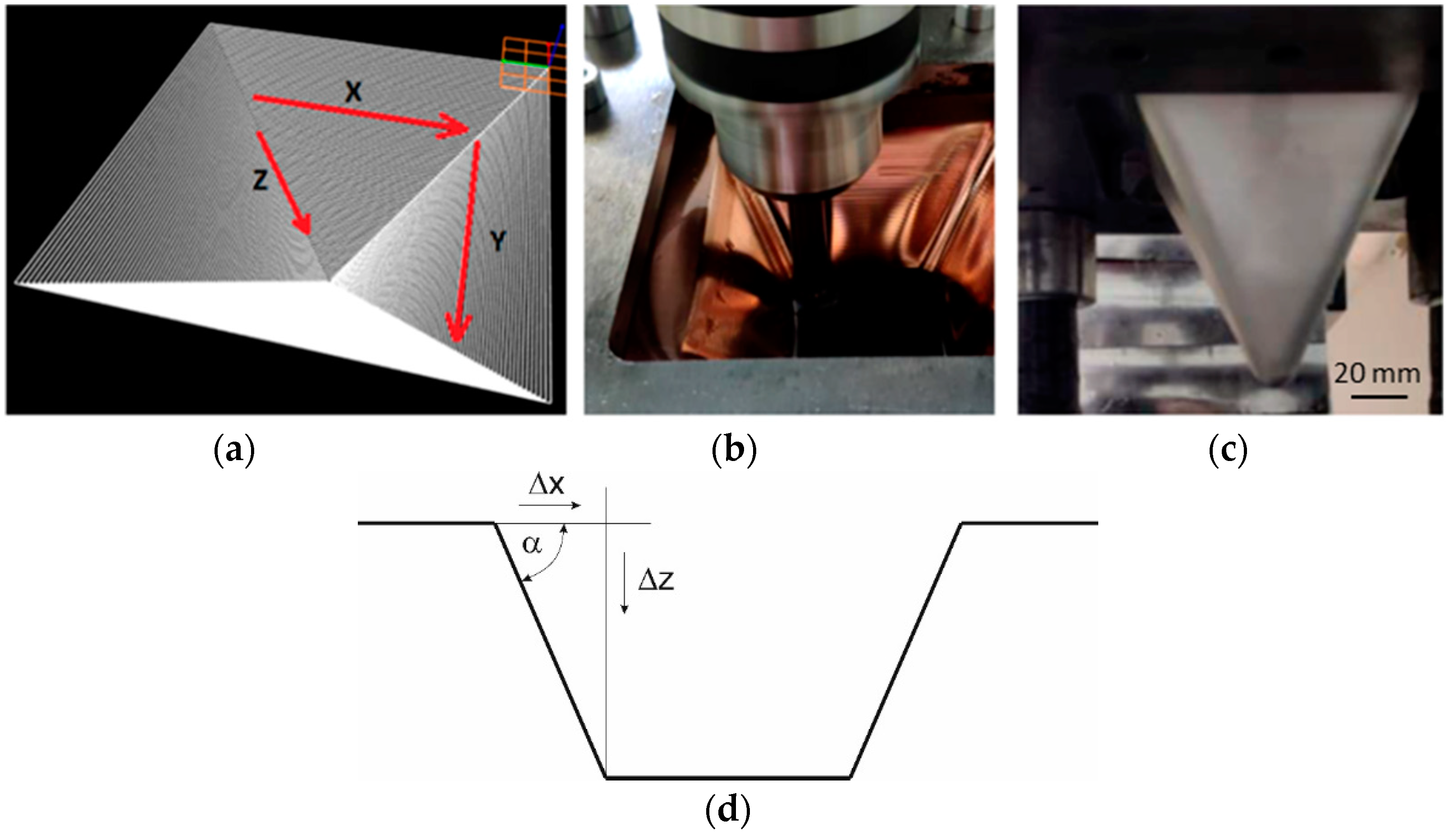

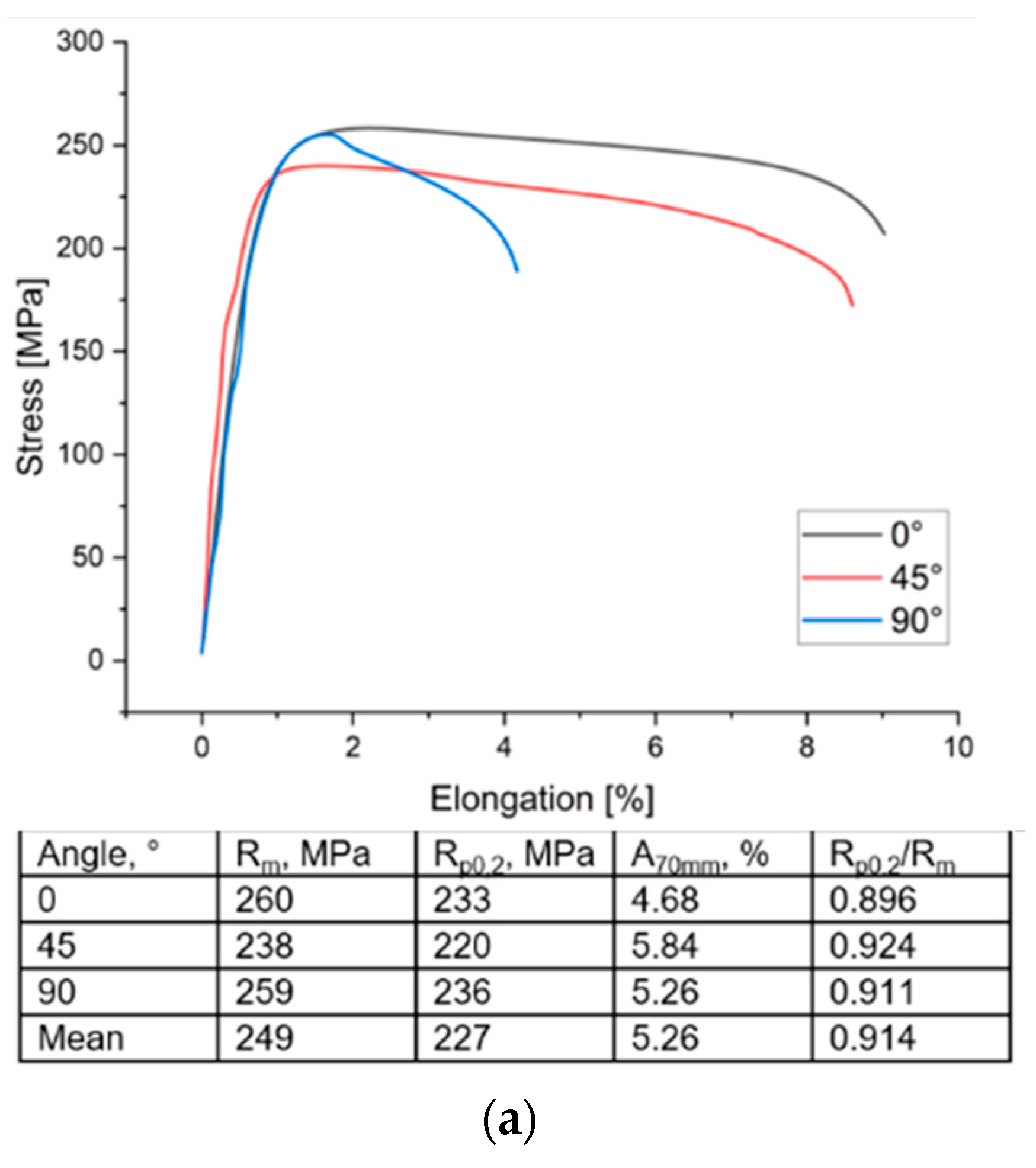

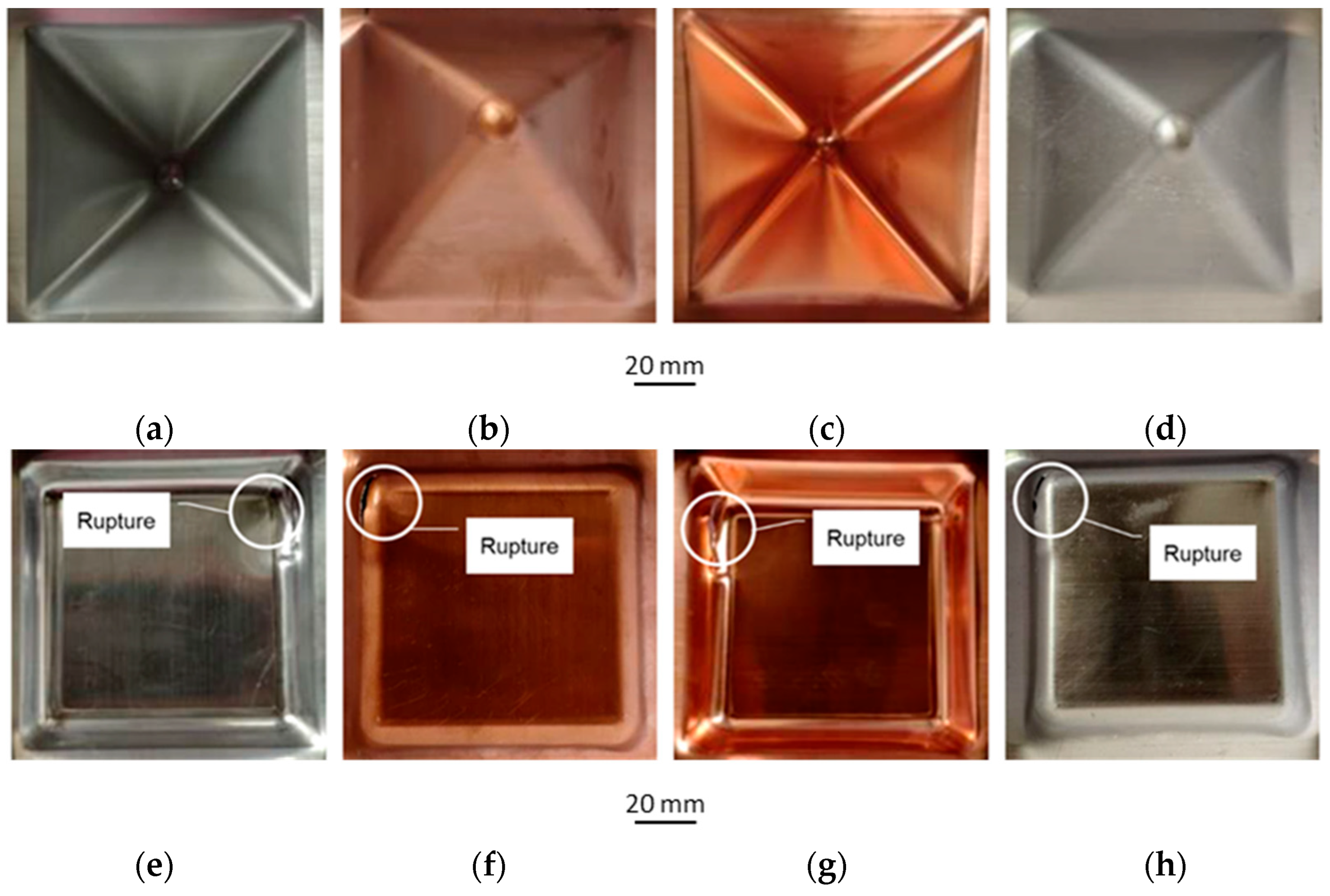

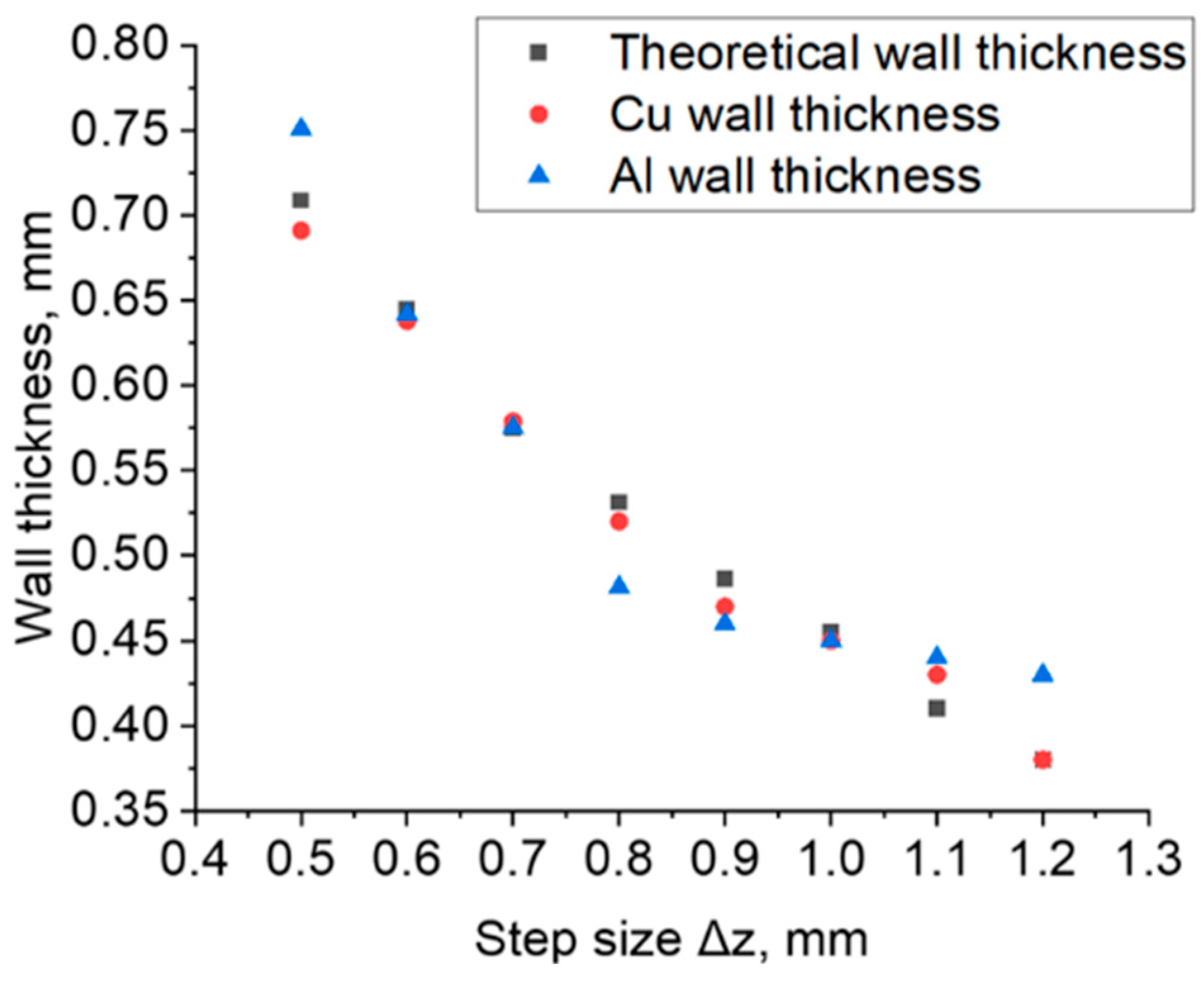
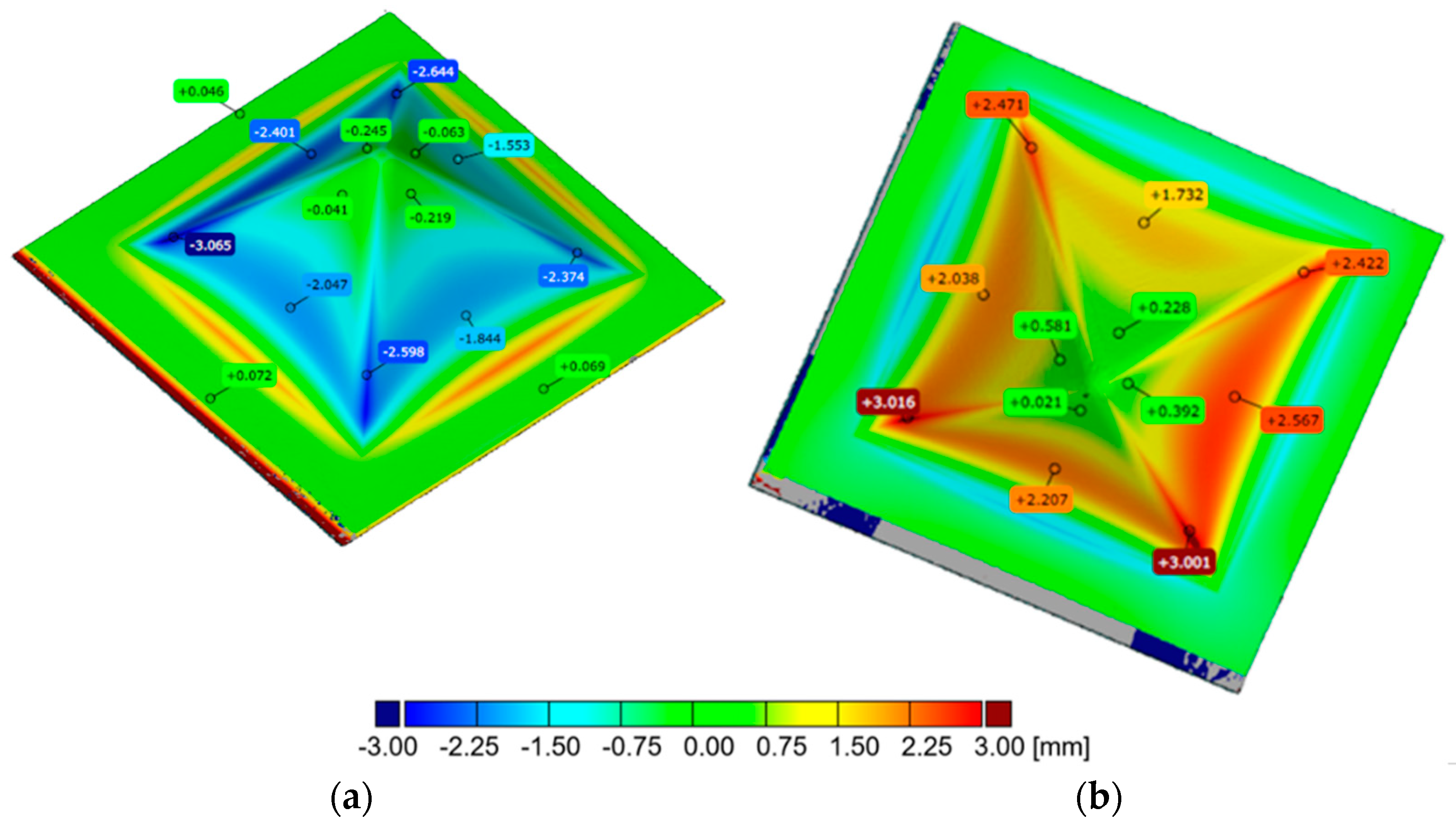
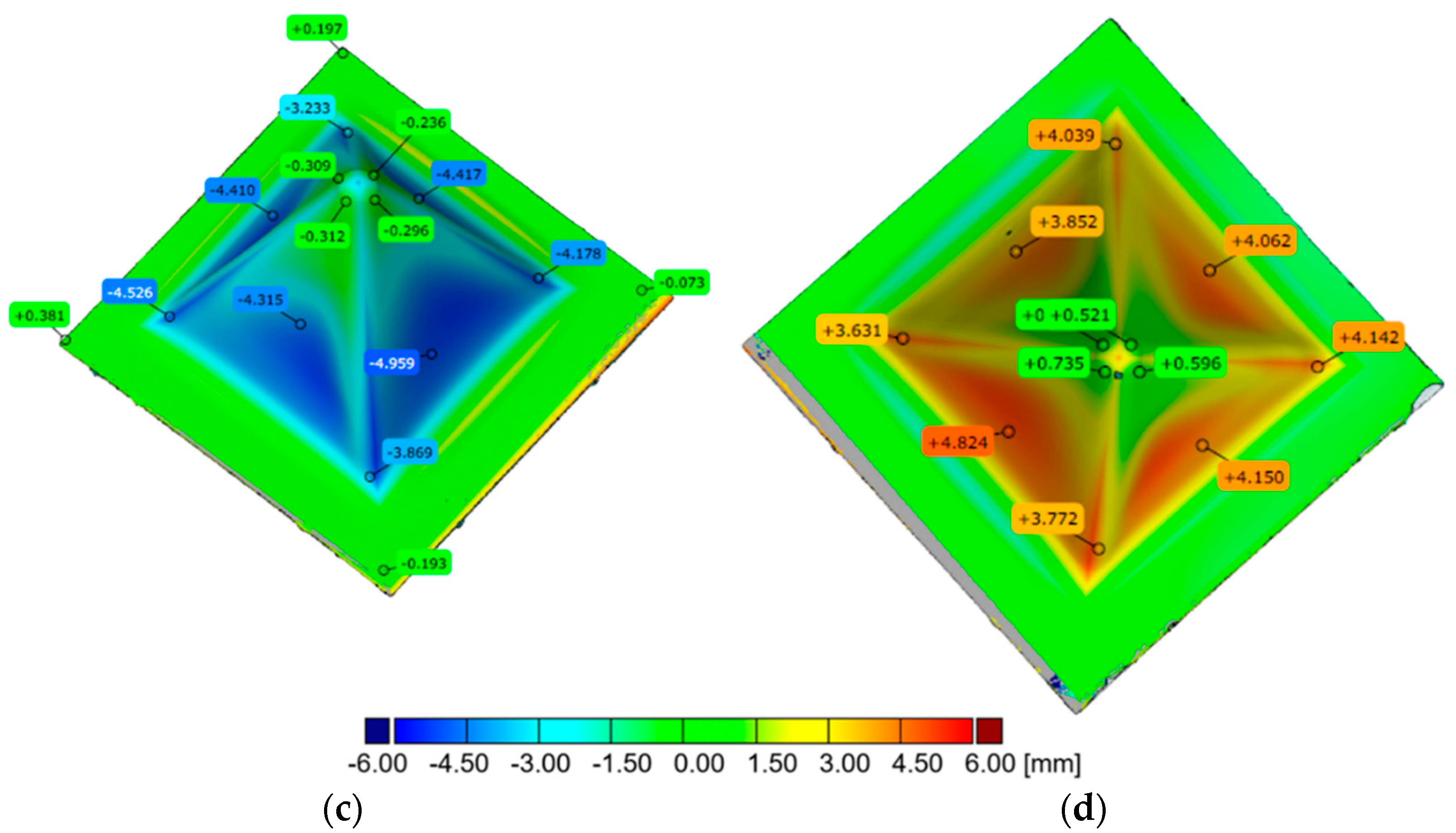
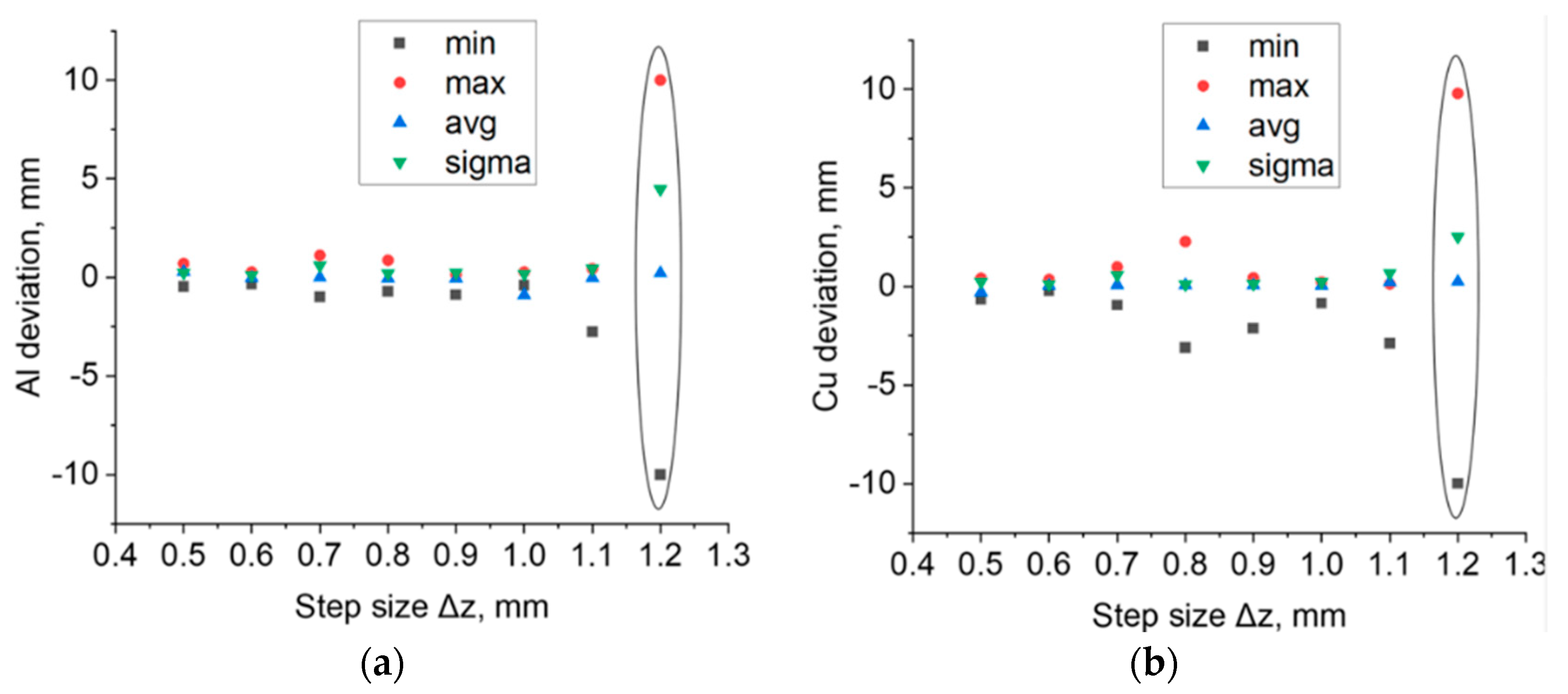

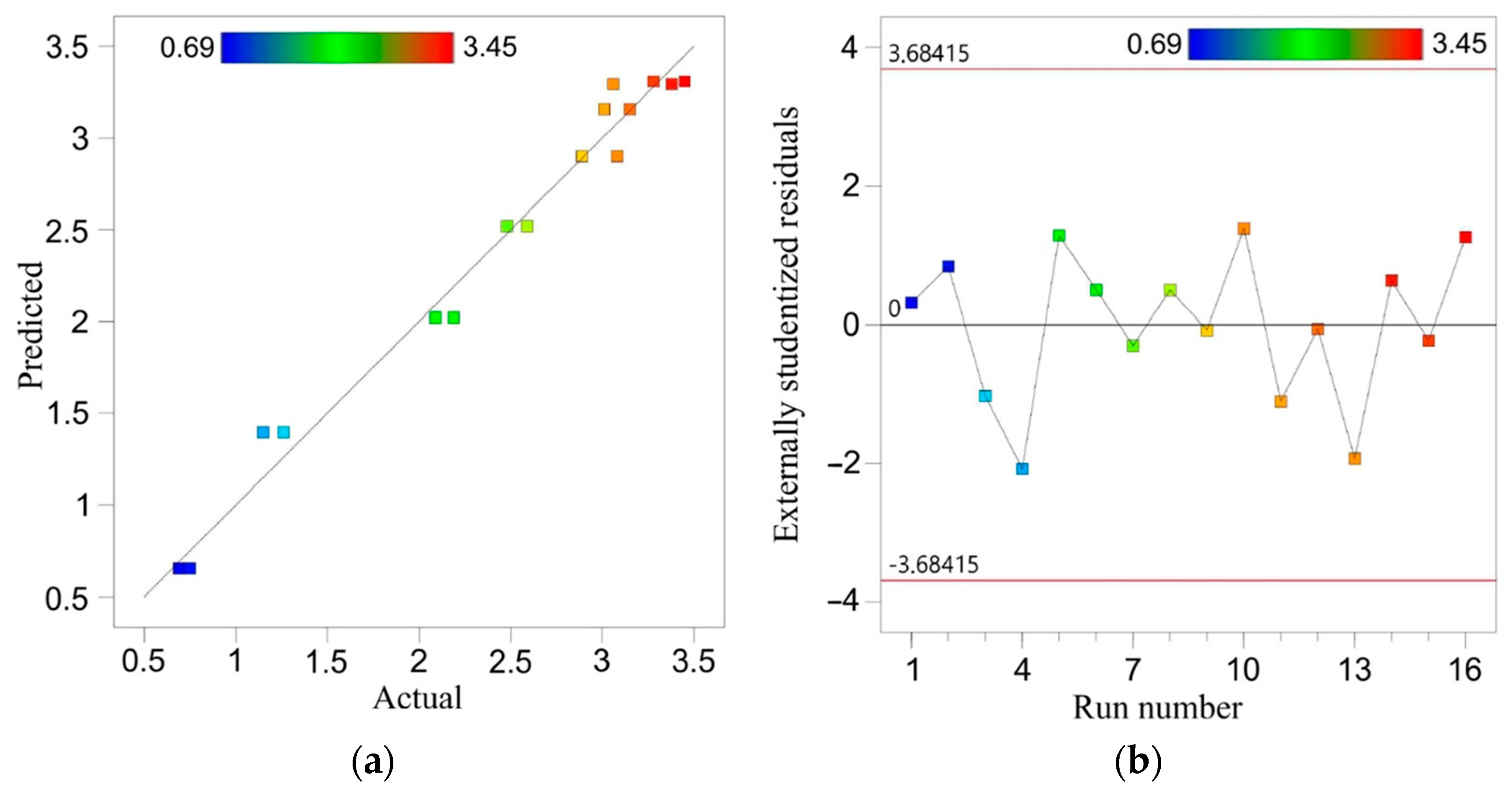


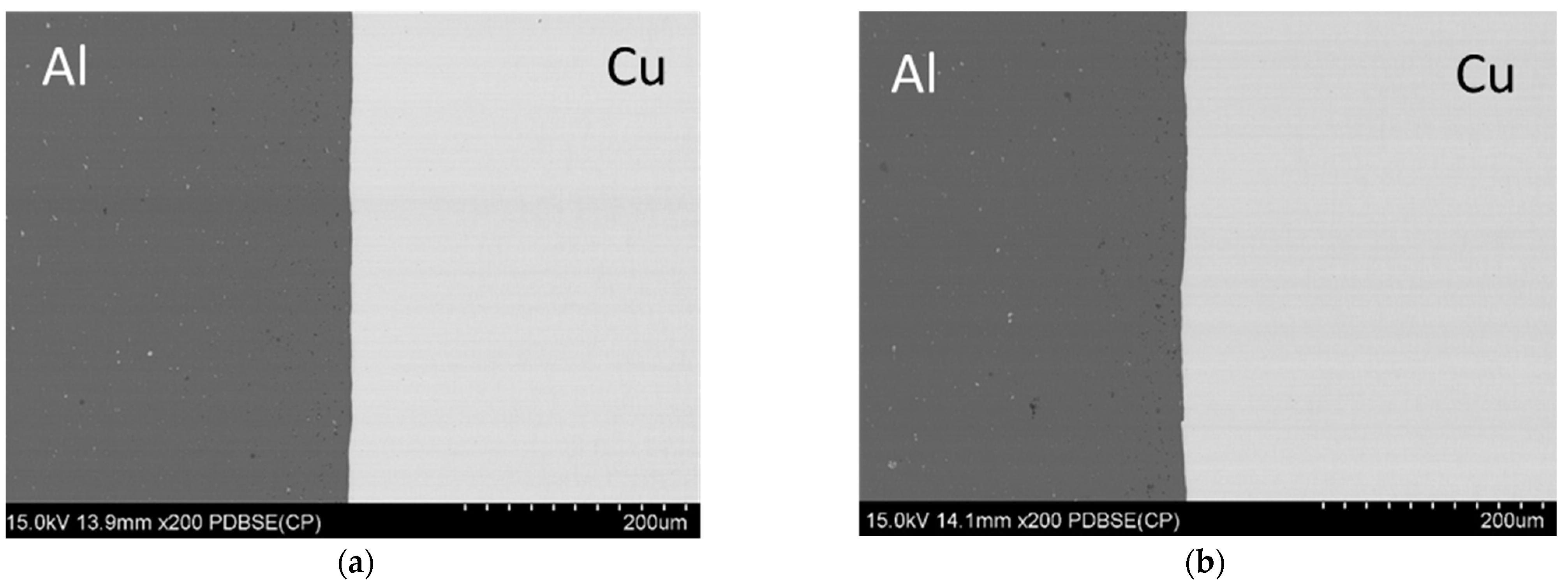
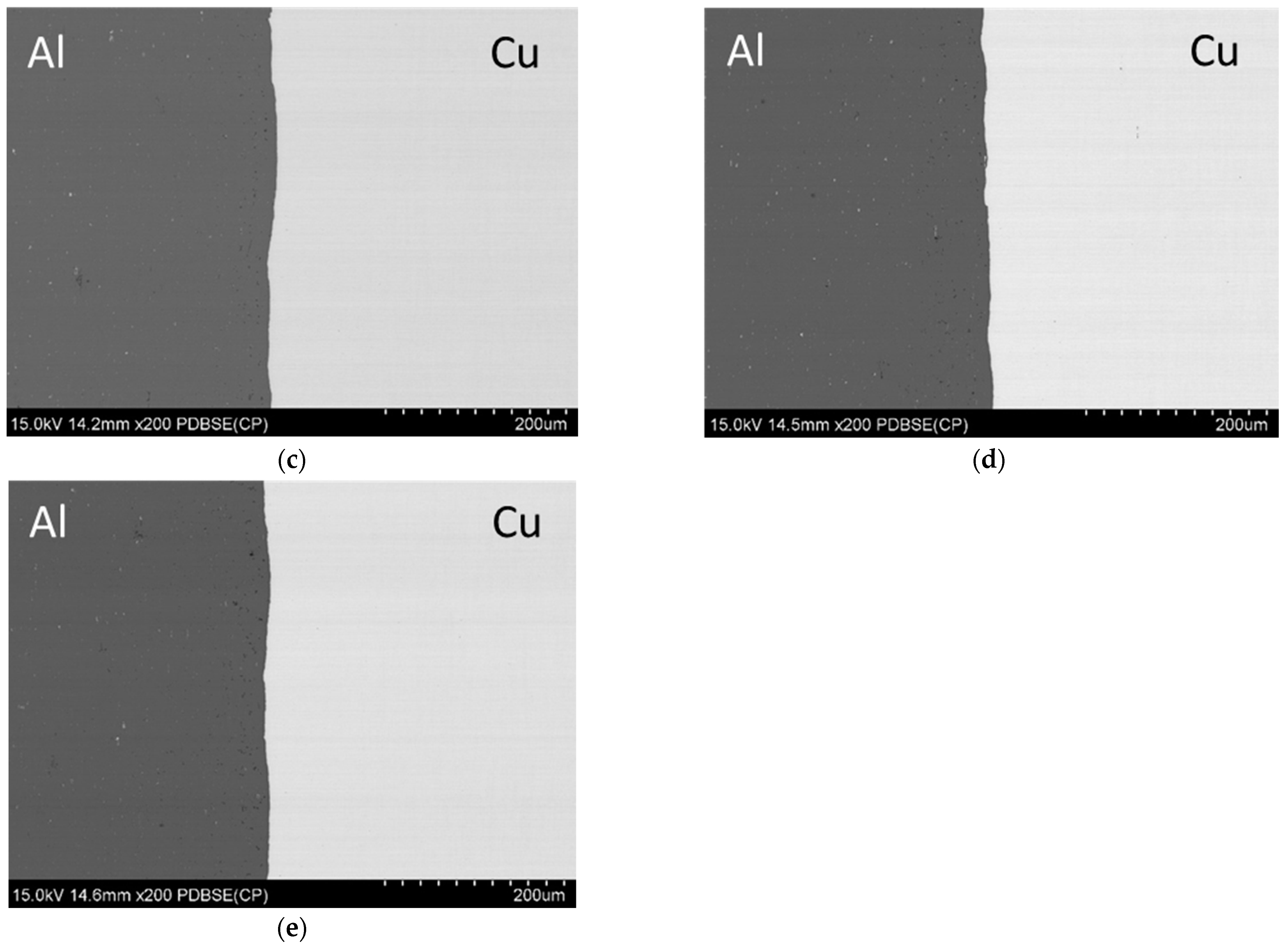
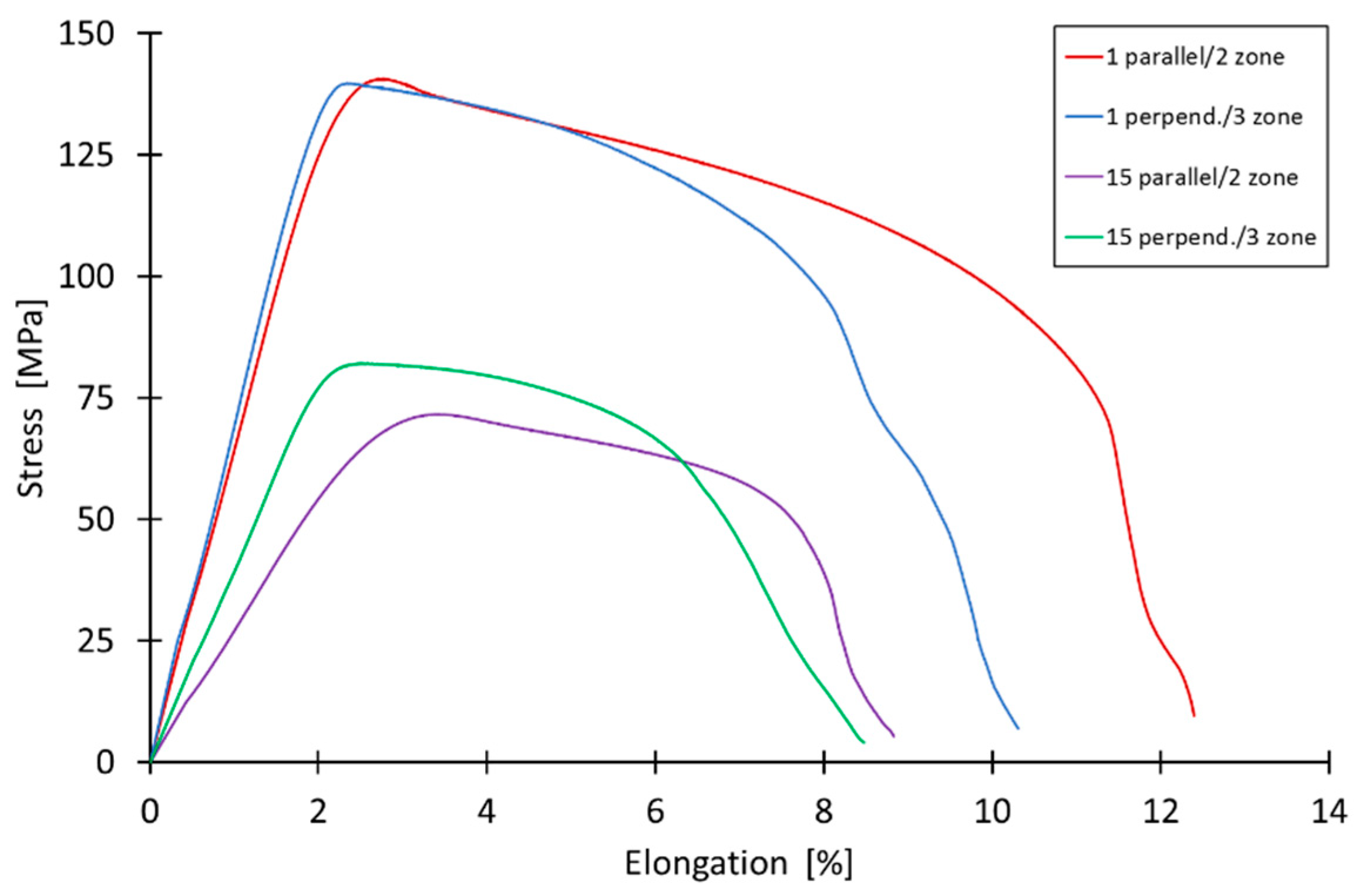
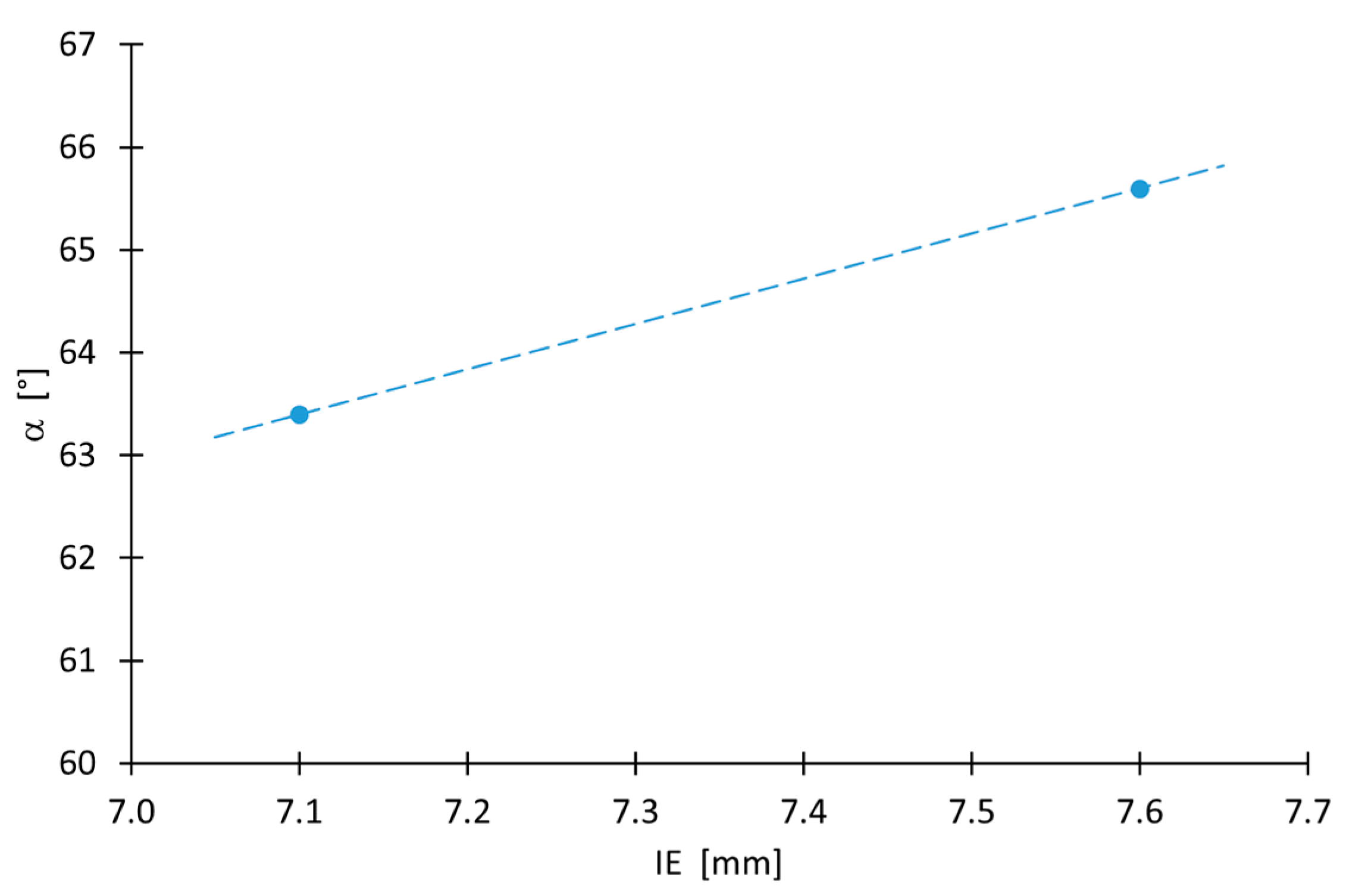
| Al | Mg | Mn | Fe | Si | Cu | Zn | Ti | Bal. |
|---|---|---|---|---|---|---|---|---|
| 99.43 | 0.025 | 0.027 | 0.23 | 0.17 | 0.028 | 0.033 | 0.029 | 0.028 |
| Cu | Bi | O | Pb | Bal. |
|---|---|---|---|---|
| 99.93 | 0.0004 | 0.036 | 0.004 | 0.029 |
| Drawpiece No. | Step Size Δz, [mm] | Wall Angle, [°] | Layer Arrangement | Tool Rotational Speed, [RPM] | Table Feed Rate, [mm/min] |
|---|---|---|---|---|---|
| 1 | 0.5 | 45.0 | Al | 600 | 100 |
| 2 | 0.5 | 45.0 | Cu | ||
| 3 | 0.6 | 50.2 | Al | ||
| 4 | 0.6 | 50.2 | Cu | ||
| 5 | 0.7 | 54.5 | Al | ||
| 6 | 0.7 | 54.5 | Cu | ||
| 7 | 0.8 | 58.0 | Al | ||
| 8 | 0.8 | 58.0 | Cu | ||
| 9 | 0.9 | 61.0 | Al | ||
| 10 | 0.9 | 61.0 | Cu | ||
| 11 | 1.0 | 63.4 | Al | ||
| 12 | 1.0 | 63.4 | Cu | ||
| 13 | 1.1 | 65.6 | Al | ||
| 14 | 1.1 | 65.6 | Cu | ||
| 15 | 1.2 | 67.4 | Al | ||
| 16 | 1.2 | 67.4 | Cu |
| Contact Layer | Al | Cu | Average Value |
|---|---|---|---|
| IE, mm | 7.6 | 7.1 | 7.4 |
| Fmax, kN | 8.5 | 8.0 | 8.3 |
| Photo of the samples | 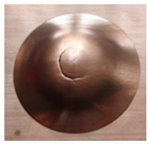 | 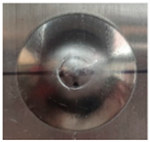 | |
 | |||
| Trial No | Visual Quality Requirements | Comments | ||
|---|---|---|---|---|
| Regular Shape | Smooth Surface | End of Path | ||
| 1–13 | Y | Y | Y | - |
| 14 | N | Y | N | The sample ruptured at a tool depth of 5 mm |
| 15 | N | Y | N | The sample ruptured at a tool depth of 10 mm |
| 16 | N | Y | N | The sample ruptured at a tool depth of 15 mm |
| Source | Sum of Squares | Degree of Freedom | Mean Square | F Value | P Value | Meaning |
|---|---|---|---|---|---|---|
| Model | 13.33 | 2 | 6.67 | 322.84 | <0.0001 | significant |
| A–step size | 12.08 | 1 | 12.08 | 585.23 | <0.0001 | |
| A2 | 1.25 | 1 | 1.25 | 60.46 | <0.0001 | |
| Residual | 0.2684 | 13 | 0.0206 | |||
| Correlation Total | 13.6 | 15 |
| Standard Deviation | 0.1437 |
| Mean | 2.41 |
| Coefficient of variance, % | 5.97 |
| R2 | 0.9803 |
| Adjusted R2 | 0.9772 |
| Predicted R2 | 0.9711 |
| Adequacy precision | 42.67 |
| Sample | Yield Stress, [MPa] | Max. Elongation, [%] | Ultimate Tensile Strength, [MPa] |
|---|---|---|---|
| As-received material (Figure 7a) | 227 | 5.3 | 249 |
| 1 parallel | 137 | 11.5 | 141 |
| 1 perpendicular | 138 | 10.3 | 140 |
| 15 parallel | 66 | 8.2 | 72 |
Disclaimer/Publisher’s Note: The statements, opinions and data contained in all publications are solely those of the individual author(s) and contributor(s) and not of MDPI and/or the editor(s). MDPI and/or the editor(s) disclaim responsibility for any injury to people or property resulting from any ideas, methods, instructions or products referred to in the content. |
© 2022 by the authors. Licensee MDPI, Basel, Switzerland. This article is an open access article distributed under the terms and conditions of the Creative Commons Attribution (CC BY) license (https://creativecommons.org/licenses/by/4.0/).
Share and Cite
Żaba, K.; Puchlerska, S.; Kuczek, Ł.; Trzepieciński, T.; Maj, P. Effect of Step Size on the Formability of Al/Cu Bimetallic Sheets in Single Point Incremental Sheet Forming. Materials 2023, 16, 367. https://doi.org/10.3390/ma16010367
Żaba K, Puchlerska S, Kuczek Ł, Trzepieciński T, Maj P. Effect of Step Size on the Formability of Al/Cu Bimetallic Sheets in Single Point Incremental Sheet Forming. Materials. 2023; 16(1):367. https://doi.org/10.3390/ma16010367
Chicago/Turabian StyleŻaba, Krzysztof, Sandra Puchlerska, Łukasz Kuczek, Tomasz Trzepieciński, and Piotr Maj. 2023. "Effect of Step Size on the Formability of Al/Cu Bimetallic Sheets in Single Point Incremental Sheet Forming" Materials 16, no. 1: 367. https://doi.org/10.3390/ma16010367
APA StyleŻaba, K., Puchlerska, S., Kuczek, Ł., Trzepieciński, T., & Maj, P. (2023). Effect of Step Size on the Formability of Al/Cu Bimetallic Sheets in Single Point Incremental Sheet Forming. Materials, 16(1), 367. https://doi.org/10.3390/ma16010367










